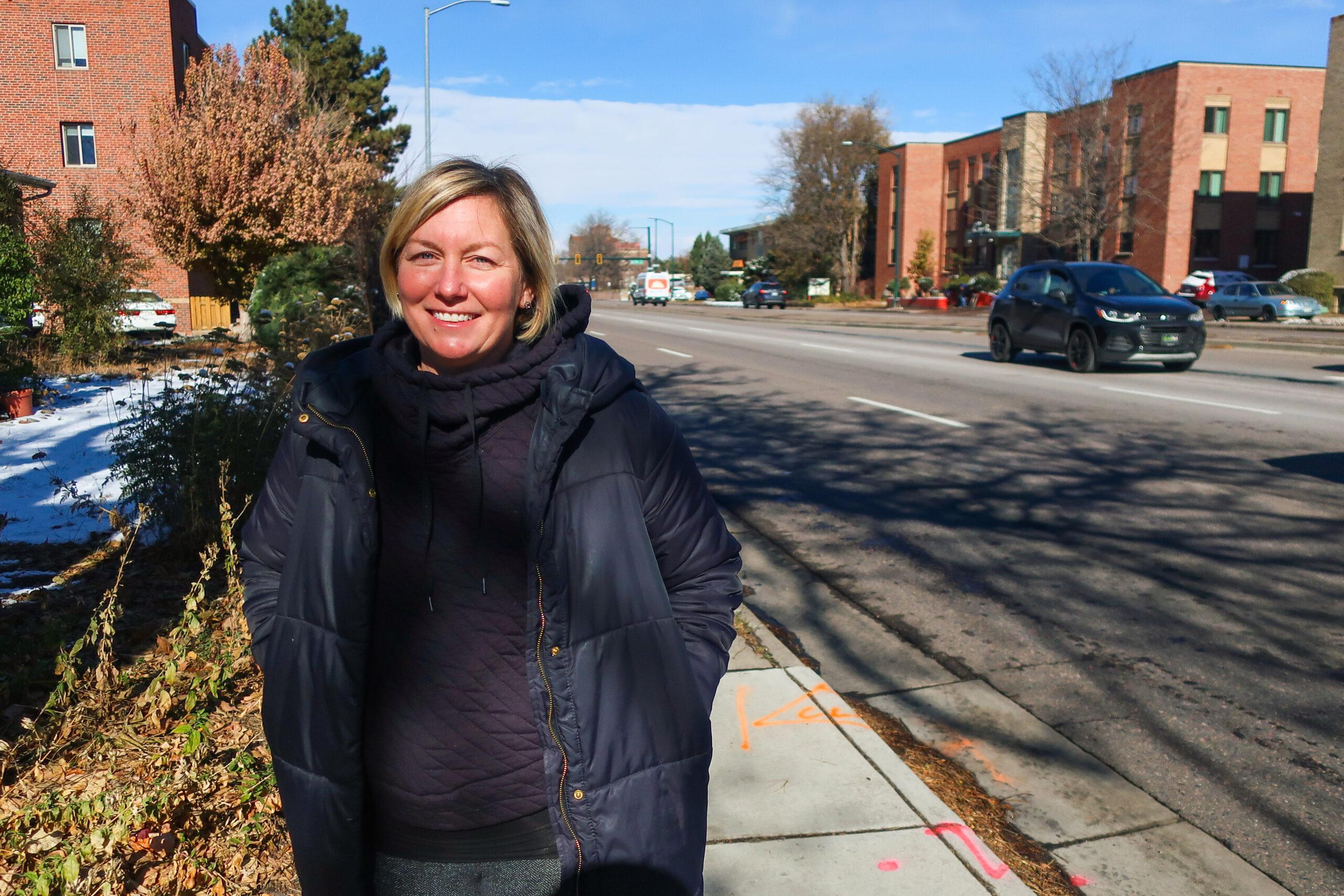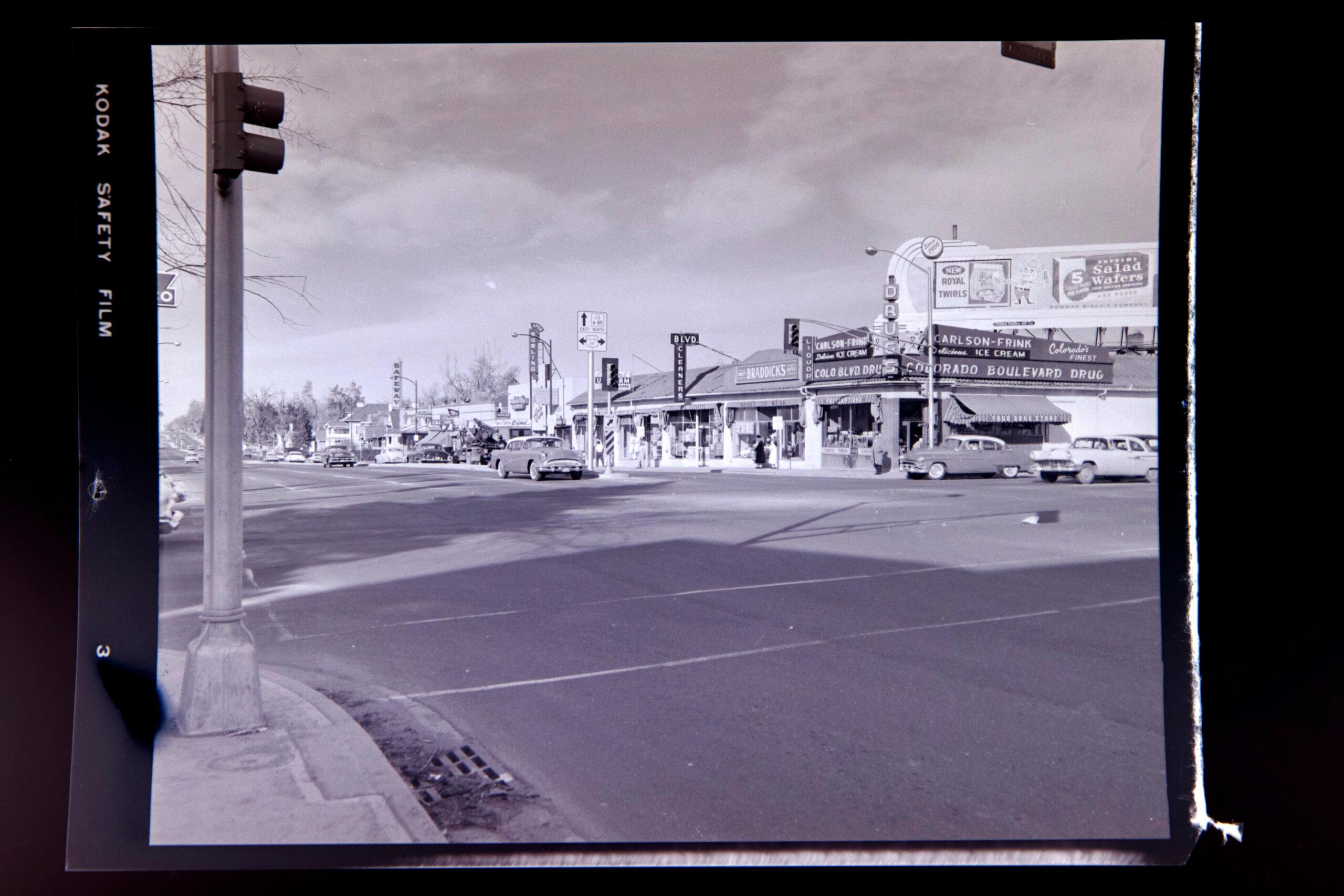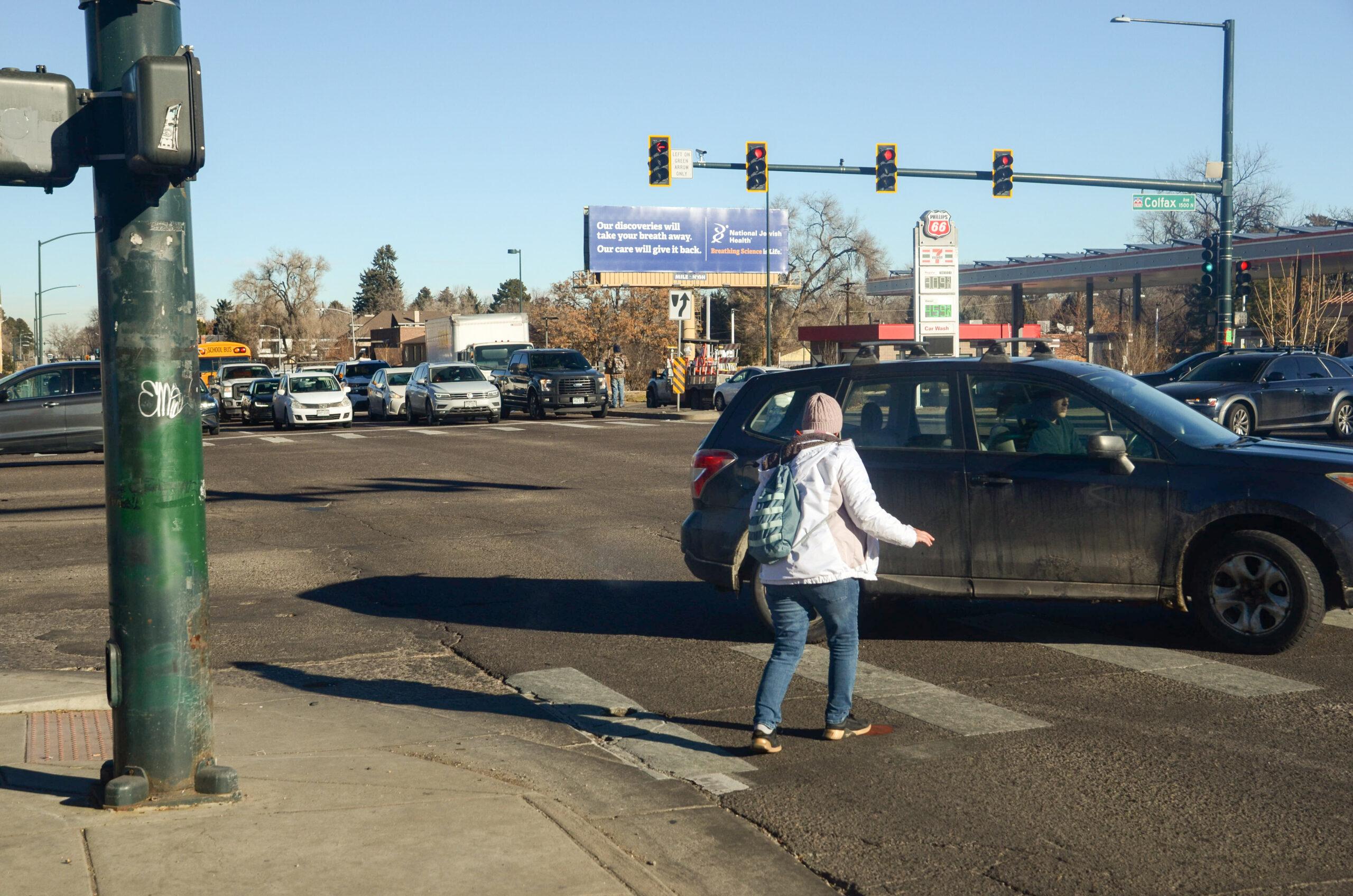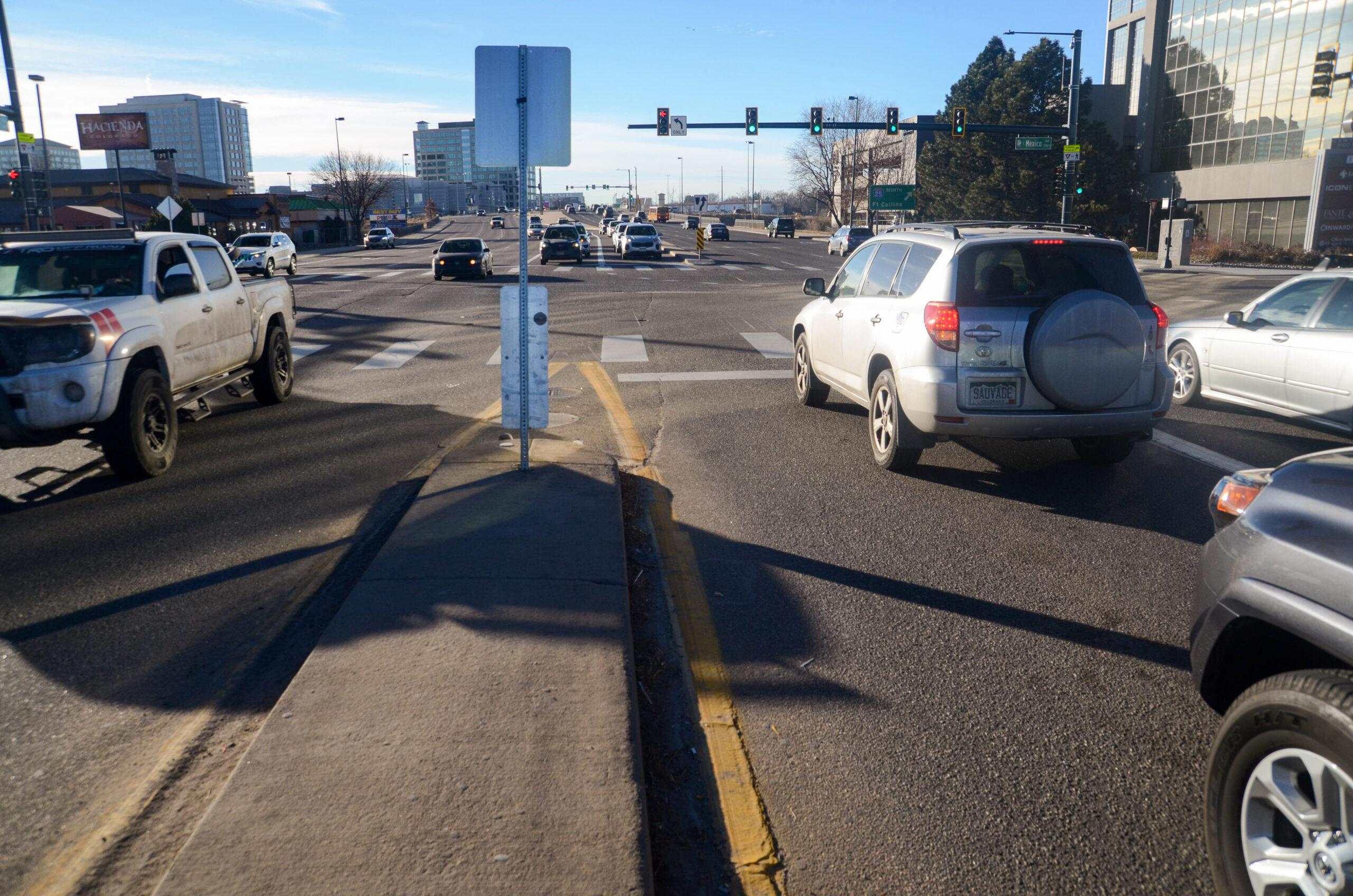Becky McBride's Congress Park neighborhood is so quiet she can often hear kids playing at the school a half-block away from her home. She loves strolling through the neighborhood with her family on its wide sidewalks.
"Everybody's just really friendly," she said of her neighbors. "We can walk to everything."
The pedestrian paradise ends just two blocks to the east at Colorado Boulevard. There, cars and trucks roar up and down six lanes of traffic day in and day out. Sidewalks are extremely narrow and, in some places, non-existent.
That's a shame, McBride said, because she and her family would like to walk more -- to more places: grocery stores, parks and other destinations. But often, they feel safer driving, even if it's just a few blocks.

The jarring contrast between a quiet, pedestrian-friendly neighborhood and its car-flooded eastern border got McBride wondering: What was the original plan for Colorado Boulevard? Has it always been an "armpit," as McBride calls it, or was the thoroughfare once a majestic tree-lined parkway like Seventh Avenue?
McBride asked Denverite to dig into Colorado Boulevard's motor oil-stained history. Here's what we found.
Colorado Boulevard is an example of both streetcar-era Denver and car-age Denver.
Generally, older neighborhoods developed when most people used public transportation tend to be more pedestrian friendly. Neighborhoods developed later -- especially after World War II -- when most people used personal vehicles, tend to be more hostile to walking. Local research on Denver's old streetcar system bears this out.
The oldest sections of Colorado Boulevard date back to the 1880s and, for a while at least, were an example of a walkable neighborhood. An aerial map from 1933 shows relatively dense, walkable development along the boulevard from Park Hill in the north to roughly Sixth Avenue on the south.

"It was very pleasant," said Alan Gass, a retired architect who grew up in a duplex on Colorado Boulevard and Ninth Avenue in the 1930s.
Gass, now in his 90s, remembers roaming the boulevard as a kindergartner and first grader: to a grocery store at Eighth and Colorado, school at Teller Elementary or a friend's house at Fifth and Albion Street. The street was no more than four lanes wide at the time, Gass said, and lightly traveled despite its status as a state highway. Trees lined the street for much of its length -- and it had wide sidewalks, too.
"There was no noise and there was no smell," Gass said.
Gass' family moved to Park Hill in the late 1930s, and then he left for college and graduate school until the late 1950s. He said Colorado Boulevard changed a lot while he was gone.


Through the mid-1920s, many U.S. traffic engineers argued against street widening. They said cars were inefficient uses of limited urban street space and advocated for less parking. Streetcar operators promoted themselves as the most efficient way to move people in tight quarters.
But in the ensuing decades, auto manufacturers that pushed for the "freedom" of wider streets and new highways won over the increasingly car-crazy general public, city officials and the federal government.
As European cities dug subway lines and built new suburbs around transit, U.S. cities like Denver reshaped themselves nearly exclusively for the automotive age. Denver's streetcar lines were ripped out in the 1950s, and the city sprawled outward. On Colorado Boulevard, homeowners complained that heavy truck traffic was causing windows to rattle and keeping them awake at night.
"It's just terrible," Ida D. Peradott told the "Rocky Mountain News" in 1950. "The house rattles and shakes."
The newspaper cited rumors that Colorado Boulevard, already technically a state highway, would become a "superhighway." While that never quite happened, the city and state did widen the boulevard significantly in a bid to reduce traffic congestion.
A 35-foot-wide strip of City Park and adjacent city-owned tree-filled land were taken for pavement in the early 1960s, despite a lawsuit from a 50-year-old widow who lived nearby. It was easier to widen the road to the south, which hadn't yet developed. Photos from the late 1950s show a wide-open South Colorado Boulevard near what is now Interstate 25, with few cars and even fewer buildings.


That wide new boulevard attracted development -- miles of gas stations, steak houses, strip malls and more -- which induced a flood of new cars to the area. By the 1970s, the boulevard had been widened "almost to the very walls of the frontage buildings," as one magazine writer put it.
"We wanted our very own 'Strip' and we got it," Gene Amole wrote in Denver Magazine in 1975. "But the glamor is gone. There is no excitement inching along through incredible traffic jams."
There were no good alternatives to driving either. Amole lamented the lack of sidewalks or space for bicycles, and residents in the tony Hilltop neighborhood and local merchants who killed the nascent Regional Transportation District's rapid transit plans for the boulevard too. He warned -- correctly, it would turn out -- that similar choices would doom similar Denver-area roads to a similar car-dominated fate.
"How long does Havana have, and Chambers Road after that? Will we ever learn?" he asked his readers. "Where will the meadowlarks go?"
That's more or less where Colorado Boulevard is today. But that's set to change by the end of the decade.
The busiest stretch of Colorado Boulevard, just north of I-25, carries some 68,000 cars a day, according to state data. At its widest, it has 11 lanes. Alan Gass calls it a "ghastly mess" that's frustrating to drive and dangerous to use in any other way.
"Everybody agrees that it's turned into a nightmare," said Gass, who's lived a block off Colorado Boulevard since the early 1960s.
Gass said he's not opposed to cars -- he's been a driver for most of his life. But he said Colorado Boulevard is an example of the unbalanced transportation system many U.S. cities have embraced since World War II.
"I always knew that the car was not the sole means of transportation," he said.

Transportation planners have long called thoroughfares like Colorado Boulevard "urban arterials" -- roads that are designed to move lots of traffic quickly through busy areas. Urban and sustainable transportation advocates now dub them "stroads," a grotesque combination of a high-speed road and a street packed with homes and businesses.
"A stroad does two things at once, and it does neither of them well," Charles Marohn, president of the advocacy group Strong Towns, said in a video explaining the concept.
The combination of high traffic volume, speed and development is dangerous. Colorado Boulevard and many other metro-area urban arterials like Sheridan, Federal, and Lincoln, make up the city's "high injury network" that accounts for 50 percent of traffic deaths. More than 25 fatal crashes have happened on Colorado Boulevard since 2013, according to Denver's Vision Zero dashboard. Among those killed were seven pedestrians and one bicyclist.
Change could be coming to Colorado Boulevard and similar urban thoroughfares. The city and state are slowly making safety improvements to those arterials, like adding medians and encouraging lower speeds through design changes.

Even bigger shifts are in the works for those roads, including Colorado Boulevard, that could make them look more like their distant past. Local, regional and state governments now plan to open "bus rapid transit" lines on Colorado Boulevard and a handful of other busy roads by 2030.
To be a true BRT line, the Colorado Department of Transportation would have to convert vehicle lanes to bus-only lanes. That would allow buses to move more quickly and could slow car traffic. CDOT has not yet decided what will happen on Colorado Boulevard, executive director Shoshana Lew said recently.
"What we're going to try and do is figure out how, in each spot, you make as many people move efficiently and as safely as possible," she told CPR News this fall. "Sometimes that could be bus-only lanes. Sometimes it could be queue jumps that allow buses to get around vehicular traffic."
The prospect of better bus service is exciting to Becky McBride of Congress Park, who said she'd love to ride transit more -- especially if RTD lowers fares. She hopes it could be another way to meet more of her neighbors, too. That happened when the city shut down a street in her neighborhood to cars during the pandemic, she said.
"I loved that street. I miss it so much," she said. "It was super neighborhoody and just a little more relaxed."
It'd be nice, McBride said, if a revamp of Colorado Boulevard could help that feeling return -- and stretch a bit farther across the city this time.
This question came to us as part of our series, Colorado Wonders. If you have a question about our state, ask us.













